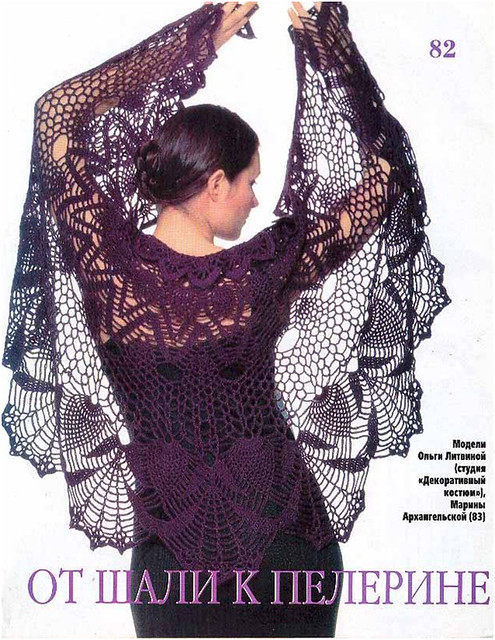Crochet lace is one of the most beautiful forms of crochet, particularly when applied to the shawl or wrap. There are so many new patterns, like Evan Plevinski's Elise shawl that I completed last month and Vicki Mikulak's Flying Diamonds lace shawl that I crocheted as my Falling Leaves shawl last summer. My most recent Finished Object: Tealiscious Half-Granny Square lace shawl trimmed with a lace edging modified from a chart by MyPicot.com. The yarn is KnitPicks Bare --Merino Wool Fingering Yarn dyed in a bath of Shapna Organic Black Tea that has a wonderful red undertone. A traditional, lacey crochet pattern enhanced by a great lace edging.
A search of Ravelry's patterns reveals more than 925 crochet lace shawl patterns, just one-sixth of the slightly more than 5,420 knit lace shawl patterns. Thankfully, the number of crochet lace patterns is growing as many contemporary crocheters look past their grandma's crochet to explore the historical application of our art.
Piecework Magazine celebrates and expresses, through its articles and projects, historic and ethnic fabric-related handwork. Lace figures prominently in this effort. For the past three years, Piecework has featured lace in its May/June issue. For many lace lovers, these issues are a goldmine, filled with the history of lace and modern updates for replicating some of the lace. Unfortunately, it's a knitter's goldmine. Crochet is conspicuous by its relative absence.
A quick perusal of the index of the three Piecework issues reveals five crochet-related articles -- one about replicating Laura Ingalls Wilders filet crochet doily, one using painter's tape to help keep loops small and consistent, one about Maltese lace versus Maltese crochet (i.e., hairpin lace), and two about a Crochet Lace challenge to replicate an edging. There also was an article about "crochet tatting" but for the life of me, I don't know how one would confuse a tatting shuttle with a crochet hook. Three issues but only two patterns.
The three annual lace issues featured articles that illustrate the history of a certain technique or style of lace -- intricate Orenburg lace, lace bonnets from the Netherlands, and the story of Herbert Niebling (the grand master of lace knitting!). No stories about the Mlle. Riego de la Branchardiere, who published patterns to replicate raised Spanish needle lace. No articles abaout Cassandra Hand, wife of the local Church of Ireland minister who introduced Clones lace in 1847 as a famine relief scheme. No stories about the role pineapple lace has played in home arts. In the spirit of openess and transparency, in 1993, 1997, and 2005, Piecework had included a few articles about Irish lace. But nothing more recent than that.
Admittedly, modern crochet, which dates to the early 1800s, is a relative newcomer to the realm of needle arts when compared to other handwork, such as knitting and embroidery. Yet, many contemporary fiber artists and designers endeavor to keep these arts alive, such as Doris Chan and her larger than life adaptation of pineapple lace to wearables, and Lisa Naskrent whose Dragonfly and Maia lace shawls seem to have a life of their own. Although my own lace shawls are not as intricate, I would hope that soomeday, my efforts (Bird of Paradise Shawl of my design) will, in some small way, help people recognize and celebrate the beauty that crochet lace is.
Perhaps it's best to let pictures do the talking. Olga Litvina, a Russian crocheter took a Japanese doily pattern and created this masterpiece!
I'll say it again. Crochet lace is one of the most beautiful forms of crochet.




1 comment:
you are so right about crochet lace. Considering crochet's roots, it's funny how the lace aspects of crocheting have all but disappeared.
Post a Comment